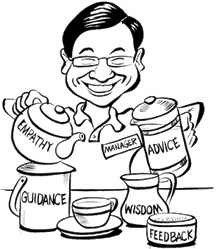 It is often thought that people in managing positions are more or less the same – they take charge, make decisions and are the center of any team. And while this is true, it is important to understand that managers differ greatly from each other just like any other employee in the company and at the end of the day they are individuals just like everyone else.
It is often thought that people in managing positions are more or less the same – they take charge, make decisions and are the center of any team. And while this is true, it is important to understand that managers differ greatly from each other just like any other employee in the company and at the end of the day they are individuals just like everyone else.
The most common way to differentiate managers is by two aspects – the way they make decisions and the way they treat their employees. This separation provides us with two very broad categories of management – autocratic and permissive, first being the sole decision maker and second only being the supervising power over the team that makes decisions for themselves. However separating all the managers only into two simple groups would be very misleading, so let’s go ahead and separate them into five!
Let’s take a closer look at the five most common manager types, the way they manage and what are the key problems they face. First up – the autocratic leader. This is the most traditional leader in a sense that they make all the decisions alone and do not take input from the members of their team. However, as you have probably already guessed if this is a leader of a big team, to make those decisions, they need a whole lot of information that is prepared for them specifically and frequently, which means using up vast time resources. What this type of a leader uses to avoid waste, are live reports included in project management tools. They give them the opportunity to see how the team is performing and coming along. This not only saves time and money, it gives the manager a live pulse on their team and allows them to make important decisions faster.
 Another leader type that is actually not so different from an autocrat in a sense that they still make all the decisions themselves is a consultative manager or simply a consultant. It is very important for a consultant to ensure team morale, and what it means in reality is that they spend most of their day listening to the opinions and notes from their team members. While this is not a bad approach on its own, with big teams it tends to be a problem. Especially when a manager is overflowed with information and fails to realize which of this information is the most important at the moment. So a project management tool that allows team members to share their opinions and comments about the ongoing tasks not only with the manager but with each other is very important for this type of manager.
Another leader type that is actually not so different from an autocrat in a sense that they still make all the decisions themselves is a consultative manager or simply a consultant. It is very important for a consultant to ensure team morale, and what it means in reality is that they spend most of their day listening to the opinions and notes from their team members. While this is not a bad approach on its own, with big teams it tends to be a problem. Especially when a manager is overflowed with information and fails to realize which of this information is the most important at the moment. So a project management tool that allows team members to share their opinions and comments about the ongoing tasks not only with the manager but with each other is very important for this type of manager.
One more example of an autocratic leader is the persuader. As you already probably guessed it from the title they manage the team by persuading it that the decisions made are the absolute best. The persuader usually organizes countless team meetings and spends many hours explaining their decisions while all of this could be done more effectively if the project statistics such as cumulative flow diagram would be available for the whole team to see and evaluate.
A complete different type of manager is the one that goes by a rule laissez – faire, which is French for giving permission to act. The manager going by this philosophy could easily be called a mentor, because of the complete freedom provided to the team to act and manage themselves. Usually this requires the team to have an easy to use project management tool that includes something similar to a scrum or a kanban board. Using a board like that facilitates the management of tasks between the team members and gives the mentor an ability to look over and to intervene only when needed.
 Lastly, we come to a manager that most of us already have at home – the father figure. And just like at home, as long as we are under his roof, we have to go by his rules. The father type bases his decisions on the knowledge of the team – by knowing each of the team members they make sure that the team is working to the full of their potential. However, when a team gets bigger, it is getting increasingly difficult keep track of all the members. In order to keep tabs on the team, these managers use tools such as time tracking that allow a better understanding on how the team members are performing.
Lastly, we come to a manager that most of us already have at home – the father figure. And just like at home, as long as we are under his roof, we have to go by his rules. The father type bases his decisions on the knowledge of the team – by knowing each of the team members they make sure that the team is working to the full of their potential. However, when a team gets bigger, it is getting increasingly difficult keep track of all the members. In order to keep tabs on the team, these managers use tools such as time tracking that allow a better understanding on how the team members are performing.
Discussed above are only a few of various management styles and it is important to realize that more often than not the management style is not chosen by the manager, but it is a reflection of their personality, their team and the project at hand. More importantly, if one of them changes, the management style of one person can easily change as well. Therefore when creating a project management tool, the focus needs to be on versatility and adoptability so the tool can accommodate the ever-changing environment. And if a tool is versatile enough, it just might happen that all the different types of managers will be using just that one tool, with no need to look somewhere else.




